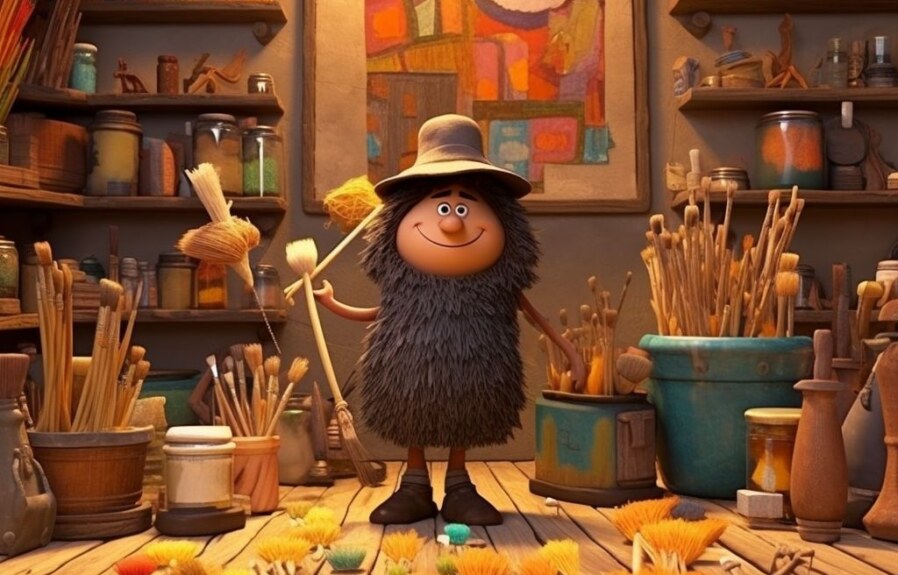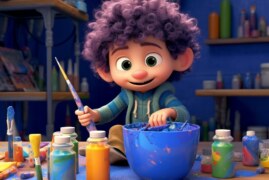Making paint from scratch can be an incredibly satisfying experience. Not only do you get to customize your colors, but you also have the ability to control the quality and chemical composition of your final product. If you’re someone who enjoys the art of creating, then learning how to make your own tan paint is a must-try project. In this article, we’ll be exploring the different methods and ingredients that you can use to create various shades of tan paint. Whether you’re a seasoned artist or just starting out, we’ll be breaking down the steps to help you achieve the perfect hue for your masterpiece. So let’s get started!
1. Understanding the Basics: What is Tan Paint and What Are the Components?
Tan paint is a versatile color that can add a warm, natural touch to any art piece or interior decor. It is a light brown color that can range in tint from very pale to dark. While tan is a neutral color, it is not a single pigment color like red or blue. Instead, it is usually created by mixing two or more pigment colors together to produce the desired shade.
The primary components of tan paint are the pigments, binder, solvent, and additives. Pigments make up the color of the paint, binder provides the paint with its adhesive properties, solvent is used to thin the paint for easier application, and additives help improve the paint’s qualities such as durability, consistency, and drying time.
To create tan paint, you’ll need to select the right combination of pigments that will produce the desired hue. This can be achieved by systematically blending different pigments until the desired color is achieved. Tan can be made with various pigments such as yellow ochre, burnt umber, raw umber, and titanium white. Of course, the exact combination will depend on the desired tint and hue.
Mixing the correct ratio of pigments to binder, solvent, and additives can be a subtle art. That’s why it’s important to understand the basic components that make up the paint and how they interact with each other. In the next section, we’ll explore the materials and tools necessary to make tan paint.
2. Gathering the Ingredients: A Comprehensive List of Materials and Tools Needed
Before you begin mixing your own tan paint, you need to gather all the necessary ingredients and tools. Here are the essential materials and tools you’ll need to make your own unique shade of tan paint.
Materials:
- Acrylic paint in primary colors (red, yellow, and blue)
- White acrylic paint (to lighten the color)
- Raw and burnt sienna acrylic paint (for a warm, earthy hue)
- Raw and burnt umber acrylic paint (for a darker, richer tone)
- Palette or mixing surface
- Water
- Paintbrushes
- Containers for mixing
Tools:
- Paint mixing knife or spatula
- Scale or measuring cup (optional, if you want to be precise with your measurements)
When buying the paint, be sure to get high-quality acrylics as they have a better pigment that will make your paint more vibrant. A flat, non-glossy finish will give you the best results for the color you desire. You can also get other shades, especially if you want to modify the tan color to get a unique result. Raw umber, for example, can be added in small amounts to darken the tone or create a more olive hue.
Make sure you have access to clean water, especially when mixing the paint, to ensure that the consistency remains smooth throughout the mixing process. Don’t use dirty water as this can affect the quality of your paint. Consider the type of brushes, which should be clean and of high quality, so that the brushstrokes are even and smooth on your painting surface.
By gathering all the materials and tools you need beforehand, you’ll have a smoother and more enjoyable mixing process. You’ll also be able to create the best quality paint that is suited to your requirements.
3. Mixing the Colors: Experimenting with Different Combinations to Achieve the Desired Hue
Mixing different colors to achieve the desired hue is a crucial step in making tan paint. Generally, tan is a pale brownish-yellow color that is achieved by mixing raw sienna and titanium white. However, this standard recipe may not always produce the desired shade of tan. Therefore, it is important to experiment with different color combinations until you find the perfect balance between brown and yellow.
To achieve unique variations of tan paint beyond the standard recipe, it is important to experiment with different ratios of colors. For instance, you can add small amounts of burnt sienna, yellow ochre, or cadmium yellow to the standard recipe to create a warmer or cooler tone of tan. Additionally, mixing quinacridone gold or yellow oxide with raw sienna can create a deeper, more earthy hue of tan.
When mixing your colors, always begin with a small amount of each pigment and gradually add more until you achieve the desired hue. It is also helpful to keep a journal or record of color ratios for future reference. Remember, the possibilities for creating unique shades of tan paint are endless, so don’t be afraid to experiment with different combinations until you find the perfect one for your project.
4. Preparing the Paint: Step-by-Step Guide to Mixing Tan Paint
Now that you have gathered all the necessary materials and tools, it’s time to start mixing your tan paint. Follow these step-by-step instructions to create a smooth and consistent mixture:
Step 1: Prepare the Surface
Before you begin mixing the paint, make sure the surface you will be painting on is clean and primed. Use sandpaper to smoothen any rough areas and apply a coat of primer to ensure the paint adheres properly. Let the primer dry completely before moving on to the next step.
Step 2: Measure the Paint and Add Tinting Colors
Measure the amount of paint you will need for your project and transfer it into a clean container. Add small amounts of tinting colors to the paint and mix well. Start with a small amount of tinting color and add more as necessary until you achieve the desired hue. Keep in mind that less is often more when tinting paint, so add a little at a time and mix thoroughly before adding more.
Step 3: Thin the Paint (Optional)
If the paint is too thick, add a small amount of water to thin it out. Be careful not to add too much water, as this can affect the color and consistency of the paint. Stir the mixture well to ensure the water is evenly distributed throughout the paint.
Step 4: Test the Paint
Before applying the paint to your surface, test it out on a small area to ensure the color and consistency are to your liking. This will also help you identify any issues or imperfections in the mixture that need to be corrected before moving on to larger areas. Make any necessary adjustments to the paint before proceeding.
By following these simple steps, you can create a beautiful and consistent tan paint for your project. Remember to take your time and be patient, as great results come from careful preparation and attention to detail.
5. Applying the Paint: Tips for Achieving a Smooth and Even Finish
While mixing your tan paint is important, it’s equally essential to learn how to apply it skillfully to your art project. Whether you’re working with canvas, wood, or metal surfaces, following the tips below can help you achieve a smooth and even finish that accurately represents the color you’ve mixed.
Tip #1: Choose the Right Brush
One of the keys to a smooth finish when applying tan paint is to use the right brush. Pick one with densely packed bristles that can hold plenty of paint, allowing you to apply it in even strokes. A wide and flat brush is ideal for covering large areas, while a small and pointed one is best for getting into corners and tight spaces.
Tip #2: Start with a Base Coat
To ensure your tan paint sticks to the surface where you’re applying it, start with a base coat. This can be a white or light gray primer that creates a smooth, even surface on which to paint. Apply the primer using light strokes and let it dry completely before applying the tan paint.
Tip #3: Apply Multiple Coats
In most cases, a single coat of tan paint is not enough to achieve the desired color or finish. Instead, apply multiple thin coats, allowing each to dry completely before applying the next. This helps to prevent drips or uneven coverage and creates a solid base for your overall project.
Applying tan paint to your art project may take time and patience, but the results are worth it. Following these tips can help you achieve a smooth and even finish that accurately reflects the hue you’ve created.
6. Going Beyond Tan: How to Modify the Recipe to Create Unique Shades of Tan
If you want to create a unique shade of tan, there are several ways you can modify the basic recipe. By experimenting with different colors and ratios, you can create a wide range of tans that will add variety to your artwork.
One way to modify the recipe is by adding a small amount of a complementary color. For example, adding a touch of blue will create a cooler, more grayish shade of tan, while adding a touch of red will create a warmer, more orangey hue. Keep in mind that a little goes a long way, so start with small amounts and gradually add more until you achieve the desired color.
Another way to modify the recipe is by playing around with the ratios of the basic components. For example, adjusting the amount of red or yellow in the mixture will create a lighter or darker shade of tan. You can also add more or less water to create a more opaque or transparent paint.
If you want to create a more textured look, you can try mixing in some different mediums or textures. Adding sand, for example, will create a grainy, beach-like effect, while mixing in some glitter will create a more sparkling finish.
Remember that the possibilities are endless when it comes to modifying your tan paint recipe. Don’t be afraid to try new things and see what works best for your artistic vision. With a little experimentation, you’ll be able to create a wide range of unique and beautiful tans that will add depth and dimension to your artwork.
7. Storing Your Paint: Best Practices for Preserving the Quality of Your Tan Paint
Once you have mixed your perfect shade of tan paint, it is important to store it correctly to maintain its quality and usability. Here are some best practices for storing your paint:
Tip 1: Store in a Cool, Dry Place
Exposure to heat and humidity can cause paint to spoil or dry out, so it is essential to store your paint in a cool, dry place. A temperature between 50-80°F (10-25°C) is ideal for paint storage. Avoid storing your paint in garages, attics, or basements that are prone to temperature fluctuations, as this can impact the consistency and color of your paint.
Tip 2: Seal the Paint Container Tightly
Air exposure can cause paint to dry out, so it is crucial to seal your paint container tightly. Make sure that the lid is securely fastened after each use, and place a plastic wrap over the opening before placing the lid. Avoid hammering the lid as it can dent and create gaps that let air in.
Tip 3: Label the Paint Container
A labeled container can help you identify your paint mixture, especially if you have multiple shades of tan paint. Label the container with the date, the components used, and the ideal environment for storage. This can help you keep track of the paint’s longevity and maintain the quality for future use.
Tip 4: Store the Paint Upside-Down to Lengthen Shelf Life
Storing paint upside-down can form a tight seal between the lid and the paint, decreasing air exposure and extending the shelf life of the paint. This is especially helpful if you plan to store the paint for an extended period. However, ensure that the lid is tightly sealed before you flip the container.
By following these best practices, you can ensure that your tan paint is preserved for future use, allowing you to achieve the perfect hue for your artwork or design project.
People Also Ask
What colors make tan paint?
Tan paint can be created by mixing equal parts of orange, brown, and white paint. However, the proportion of each color can be adjusted to create a darker or lighter shade of tan.
What is the best way to lighten tan paint?
To lighten tan paint, add small amounts of white paint to the mixture until the desired shade is achieved. It’s recommended to mix the paint thoroughly to ensure an even distribution of color.
Can you create different shades of tan paint?
Yes, you can create different shades of tan paint by adjusting the amount of each color utilized in the mixture. If more brown paint is added, the resulting shade of tan will be darker. The addition of more white paint will create a lighter shade of tan.
What are some other options for making tan paint?
In addition to mixing orange, brown, and white paint, tan paint can be created by mixing yellow and raw sienna. Another option is to mix yellow, red, and a small amount of blue paint to create a sandy tan color.
Is it necessary to have a specific type of paint to create tan paint?
No, any type of paint can be used to create tan paint. Whether it’s oil-based or water-based, the mixing process is the same.
Conclusion
Making tan paint is relatively easy by mixing equal parts of orange, brown, and white paint. By adjusting the proportion of each color, you can create darker or lighter shades of tan. You can also create tan paint by mixing yellow and raw sienna or by combining yellow, red, and blue paint. Regardless of the type of paint used, thorough mixing is essential to achieving an even distribution of color.



